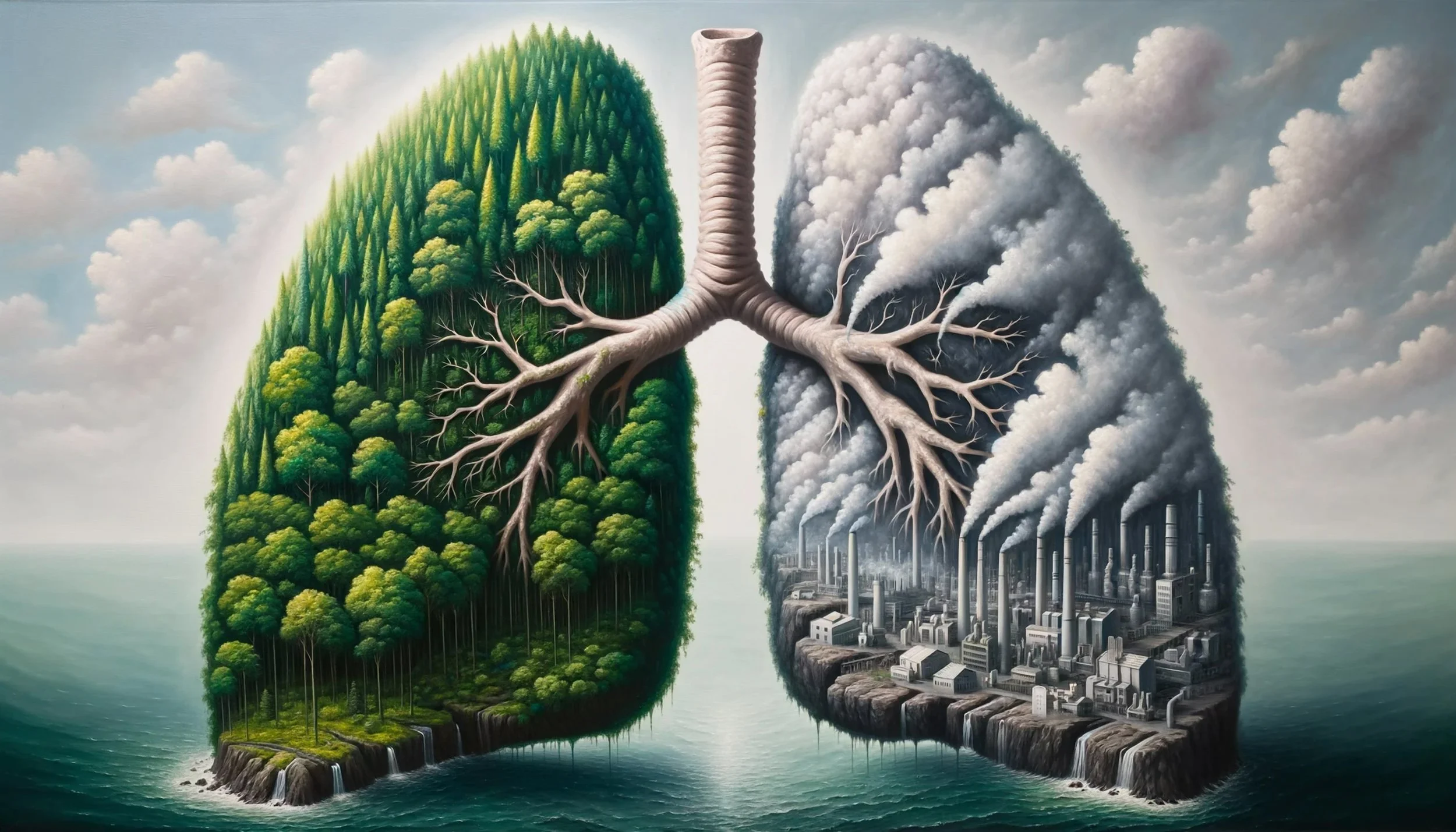12 Hidden Climate Change Health Effects
Written by May Myo Myint, MS
When I was growing up in the 2000s in my home country of Myanmar, a tropical region of the world, we used to have three seasons: hot, rainy, and cold. However, after a decade, we started to notice that our cold season was disappearing.
Now, during what used to be our cold season, it only feels a little chilly in the very early morning around 7 am. The rest of the day is as hot as the summer. Our hot season has also become significantly hotter than it was a decade ago.
Nowadays, we say we only have two seasons: the rainy season and a long hot season.
You might be noticing similar changes in your region as well, where the weather patterns you once knew are shifting. This phenomenon called climate change–the long-term change in the average weather patterns–is no longer unique to a single country or region. In fact, it’s become even more evident as we are physically experiencing the effects of climate change regardless of where we live.
Climate change has far-reaching, indirect health effects. Yet, there are many that you might not even realize.
That’s why as our generation continues to face the effects of climate change, we must provide ourselves with as much information as we can to take preventative measures and safeguard our health as we adapt to these environmental changes.
Air quality deterioration
Respiratory issues, asthma exacerbation
Did you know that heat waves can affect your lungs and heart?
According to atmospheric monitoring data, heat waves are associated with higher levels of ground-level ozone, a harmful pollutant that can lead to respiratory illnesses. Ozone irritates lung tissue, causing shortness of breath, coughing, and an increased risk of lung infections and inflammation.
This is especially problematic for people living with asthma, as breathing in hot air causes the airways to tighten and narrow, triggering symptoms.
Higher levels of airborne allergens
Over the past 40 years, pollen seasons have grown by 20 days and had 21% more pollen, according to a study published in the Proceedings of the National Academy of Sciences.
Due to extended pollen seasons and increased pollen production, we are faced with longer lasting and more severe seasonal allergies along with worse outcomes for asthma.
Cardiovascular problems, lung irritation
The formation of increased ground-level ozone and higher temperatures can also lead to cardiovascular (heart) problems. Those along with lung problems are caused by frequent and intense wildfires.
Extreme heat makes wildfires more likely, especially in places like California which has a dry environment. These fires release air pollutants of concern for our health, such as particulate matters, carbon monoxide and nitrogen dioxide, into the air.
Water quality issues
Gastrointestinal illnesses, infections
Extreme weather events, such as heavy rainfall, heat waves, and droughts, are becoming more frequent and intense. When heavy rains hit land surfaces, they collect pollutants like oil, plastics, and lawn fertilizers. Often, they overwhelm drainage systems and flow directly into rivers, lakes, and coastal waters, leading to significant water pollution.
On the flip side, heat waves and droughts can be just as harmful to water quality. These events lower the diluting capacity of water, resulting in higher concentrations of pollutants, particularly salt, in the remaining water supply.
Exposure to polluted water can lead to a range of health issues, from stomach problems and skin irritation to more severe conditions like liver and kidney damage, neurological disorders, and an increased risk of infections. Government agencies and environmental monitoring organizations frequently issue warnings and alerts regarding water quality as needed, so it's important to stay informed about local advisories and take appropriate precautions.
Liver damage, neurological problems
During heatwaves, another troubling problem is algal blooms. When temperatures rise and nutrients from fertilizers enter lakes and rivers—especially those with restricted water flow due to dams—algal blooms can flourish. You might see these blooms as blue-green, red, or brown patches on the water’s surface, but sometimes they grow at the bottom, making them harder to spot.
Exposure to the toxins from harmful algal blooms can happen through swimming in or drinking contaminated water, or eating seafood that has been affected. This can lead to health issues like skin irritation, stomach problems such as nausea and vomiting, and in severe cases, liver damage and neurological effects.
Hypertension from increased sodium intake
Sea level rise due to climate change is a major contributor to a water quality issue called saltwater intrusion in coastal areas, which contaminates our freshwater supplies. Normally, freshwater in underground aquifers keeps saltwater from the ocean out because of the pressure it creates.
But as sea levels rise, this pressure balance gets disrupted, allowing salty ocean water to seep into the freshwater reserves. This means the water can become too salty for drinking, farming, and industrial use.
Drinking water that’s too salty can lead to health issues like dehydration, high blood pressure, and a higher risk of cardiovascular diseases and chronic kidney problems.
Malaria, dengue fever, Zika virus
In June, the Centers for Disease Control and Prevention (CDC) issued a warning about an increased risk of dengue fever in the United States. Climate change is partly to blame. As temperatures rise and weather patterns shift, places that used to be too cold or dry for disease-carrying insects, like mosquitoes and ticks, are now becoming ideal habitats for them. This means that these insects, which can spread diseases like malaria, dengue, and Zika, are moving into new areas and putting more people at risk.
Measures for preventing malaria, dengue fever, and Zika virus focus on protecting yourself from mosquitos. These include:
Wearing protective clothing
Using insect repellent on your skin
Staying indoors or being in well screened outdoor areas
Eliminating areas with standing water where mosquitoes like to breed
Additional preventive measures include a vaccine for dengue if a person has been infected previously, preventive drugs and sleeping under an insecticide-treated bed net for malaria and using condoms or abstaining from sex to prevent Zika transmission by an infected partner.
Food safety and security
Food insecurity, malnutrition, nutritional deficits, and micronutrient deficiencies
As the climate changes, it’s not just the weather that’s affected—our food and the nutrients it provides are at risk too. Here’s how different climate factors are impacting the crops and livestock we rely on for essential vitamins and minerals:
Increasing Carbon Dioxide and Rising Temperatures: Plants need carbon dioxide to photosynthesize, but too much of it, combined with higher temperatures, disrupts this process. Researchers have found that increasing carbon dioxide and rising temperatures decrease the yields of crucial crops like rice, wheat, barley, legumes, vegetables, fruits, and nuts. This means fewer of these foods are produced, and those that may have lower nutritional content.
For instance, elevated CO2 levels can reduce the amount of essential nutrients like zinc, iron, and protein in major crops by 3-17%, and decrease B vitamins in rice by 13-30%. This decline could increase the risk of nutritional deficiencies for millions of people, including over 100 million at risk for zinc and protein deficiencies, and 1.4 billion women and young children vulnerable to iron deficiency anemia.
Extreme Weather Events: Extreme weather, like droughts, floods, and strong winds, can cause water shortages, damage crops, and degrade soils. These events lead to reduced crop yields and, in some cases, complete loss of crops. Fruits and vegetables are particularly sensitive to these changes, as they often need specific conditions to grow.
Moreover, extreme weather events can disrupt transportation and storage systems, causing significant delays in getting food from farms to markets. Flooded roads, damaged infrastructure, and power outages can spoil perishable goods, further exacerbating food shortages and leading to higher prices and increased food insecurity.
Sea-Level Rise: Rising sea levels can flood coastal areas, cause saltwater to seep into farmlands, and make groundwater unfit for irrigation. This leads to the loss of crops, including fruits and vegetables grown in coastal regions. Additionally, sea-level rise can result in the loss of coastal fisheries and coral reefs, which are vital habitats for many fish species.
Ocean warming: Beyond coastal fisheries, ocean warming and declining oxygen levels are reducing the suitable habitat for marine life. This results in fewer fish and a decline in seafood catch, which is a vital source of essential nutrients for many communities. As seafood availability decreases, it could have serious nutritional impacts, especially for populations that rely heavily on fish for their diet.
Gastrointestinal diseases and food poisoning
Have you ever noticed that food spoils faster in the summer? This isn't just an inconvenience—it's a sign that warmer temperatures are creating a perfect environment for certain bacteria and parasites to thrive, which increases the risk of foodborne illnesses and gastrointestinal problems.
As temperatures rise, bacteria like – Salmonella and Campylobacter, commonly found in foods like chicken, eggs, and dairy, and Vibrio, found in certain coastal waters and undercooked seafood – can grow more quickly, increasing the chances of food contamination.
The CDC has estimated that Salmonella alone has caused ~1.35 million infections, 26,500 hospitalizations, and 420 deaths in the United States.
In addition, parasites such as Cryptosporidium and Giardia, which can cause severe diarrhea and other gastrointestinal problems, also thrive in hot and humid conditions. These parasites can reach us through contaminated water, such as untreated tap water, lakes, or streams, and even through foods like fruits and vegetables that have been washed with infested water.
Lastly, like we mentioned earlier, harmful algal blooms are becoming more common as ocean temperatures rise. These algae produce toxins that accumulate in fish and shellfish, posing a significant risk of food poisoning when consumed.
To protect yourself, make sure to:
Avoid drinking untreated water.
Avoid consuming unpasteurized milk or dairy products.
Keep perishable foods properly refrigerated.
Cook meats and seafood thoroughly as necessary.
Ensure that your water is safe.
Wash fruits and vegetables thoroughly.
Stay informed about seafood safety, especially during warmer months.
Mental health impacts
Eco-anxiety and climate grief
It is important to realize that climate change is not only affecting our physical health but also taking a toll on our mental well-being.
Due to stress from our awareness of climate change, members of our generation can face both eco-anxiety and climate grief. In fact, in the 2022 Climate Change and the American Mind survey out of Yale University, researchers found that millennials and Gen Z are more likely than Baby Boomers and older generations to experience at least mild levels of Climate Change Psychological Distress.
Furthermore, the phenomenon of “summer anxiety” is real. Extreme heat can have negative effects on mental health and cognitive functions. This is well supported by data – statistics find a direct relationship between:
Car crashes and heat wave events
Mental health related emergency visits and hottest summer days
Crimes and warm weather
PTSD, acute stress disorder
There are many ways in which extreme heat events can affect our mental health.
Extreme heat itself can not only cause physical discomfort, but also it can cause psychological stress. People may worry about their health, the impact on their daily activities, and this adds up to the overall stress of coping with the heat. You can also have post-traumatic stress after living through extreme weather events, including hurricanes, tornadoes, and earthquakes.
High temperatures can also affect our sleep. Getting poor quality sleep can exacerbate mental health issues like anxiety and depression.
Social isolation, cultural loss, identity issues
Lastly, the effect of climate change can also be felt in uprooting people from their homes.
Extreme weather events and droughts are making land uninhabitable, forcing communities to move. This displacement leads to breakdown of community life with social disruption for climate migrants and ultimately causes a refugee crisis.
Conclusion
Recently, I watched One Word, a powerful documentary featuring the Marshallese people, who face the threat of climate displacement due to rising sea levels. Despite their challenges, their message is clear: “We are not drowning, we are fighting.”
It is a call-to-action for us to work together to create meaningful change in our environment because together we can positively impact our world.
Subscribe to the YMyHealth newsletter to stay up to date on everything that’s health-related for millennials!





